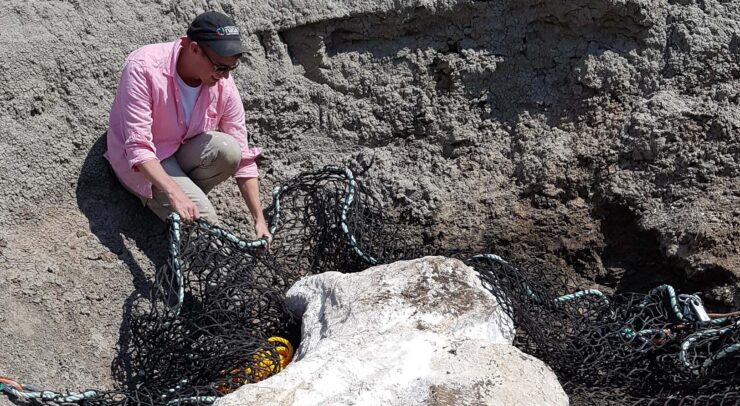Mallon discusses what to expect at a dig, dino myths and why dinos were so big
Jordan Mallon is a research scientist at the Canadian Museum of Nature here in Ottawa. He mainly studies horned dinosaur evolution and dinosaur paleoecology which is the study of past ecology. This week Mallon interviewed with the Fulcrum to discuss dinosaurs, digs, and all your burning questions about life on Earth millions of years ago.
“There’s a species I described called Spiclypeus shipporum about five years ago. That’s on display right now at the museum. I’m working on describing some new species. I’ve worked on looking at growth and variation in horned dinosaurs and what that can tell us about, you know, how these animals grew up and how one species might differ from another,” said Mallon describing his research.
Currently, Mallon and his undergraduate students are looking at the neck musculature of horned dinosaurs and the area on the bones where the muscles would have been attached. By studying this, they’re hoping to learn more about how the head was used and wielded while the dinosaurs were alive.
What to expect at a dinosaur dig?
Mallon often works in a specific field area near the village of Hilda in Alberta. More specifically, there is a vast stretch of badlands north of Medicine Hat, where a number of fossils have been recovered.
In terms of finding fossils, “it’s just a matter of having boots on the ground and walking along with a sharp eye. You’re out there for days and weeks on end and if you’re lucky, maybe you’ll find a little trail of eroded bone. You can follow it along and if the good Lord is on your side maybe you’ll see a big tibia eroding out of the hillside.”
“In some cases, you can get pretty lucky. For example, back in 2015, or 2014, I found the skull of the horned dinosaur Chasmosaurus, which are quite rare as far as dinosaur fossils go. It took a couple of years to dig it up. Ultimately, we had to get it out of the Badlands with a helicopter, which was a lot of fun,” he added.
How do scientists reconstruct dinosaur images?
Mallon explained that over many decades and centuries scientists were able to accumulate a collection of fossils to aid in creating a general idea of a specific dinosaur build.
Paleontologists can look at their muscle insertions, which are scars left on the bone that show where the muscle was attached. From looking at those muscle attachments, we can determine the size of the muscle, as well as which direction it was laying across the body.
In addition to fossil records, scientists can study the living relatives of dinosaurs like birds and reptiles to learn about the muscle to determine whether or not they shared the same myology (muscle structure).
For reconstructing skin there are a number of skin impressions preserved from dinosaurs, “we know for example that some of the horned dinosaurs had big scales, they weren’t feathered. They had big scales. And the reason we know that is because we found skin impressions alongside their skeletons,” added Mallon.
What were the biggest dinosaurs and how did they become so large?
According to Mallon, the biggest dinosaurs were the sauropod dinosaurs, which were the long-neck dinosaurs. They are unique because of their extremely long necks, which scientists believe was an adaptation for feeding.
Mallon continued, “their long crane necks allowed them to feed across a huge swath of land while expending very little energy. Meaning that they could eat all day and turn all that food energy into growth. So these sauropods were more easily able to convert food energy into body mass.”
Additionally, sauropods are not mammals, and as a result, had comparatively slow metabolisms. Consider a giraffe, which also has a long neck and they do have high metabolisms. To maintain themselves, they must keep eating because a large majority of energy that they take in is lost to heat as a result of their high metabolism.
Sauropods and other dinosaurs had hollow bones, “their vertebrae were especially full of what are called pleurocoels which are just big vacant air sacs within the bones. Although their bones look big to the eye, they are actually not very dense. So this would have served to lighten up the skeleton. So they could afford to grow bigger because there were these efficiencies.”
Dinosaur myths we need to debunk
When asked which dinosaur myth Mallon would like to debunk, he responded, “Oh, boy. There’s a lot of them. The biggest myth would maybe be that everything that lived in the past was a dinosaur. People seem to think that if it’s a fossil, it’s a dinosaur. If you dig a skeleton out of the ground, there you just found a dinosaur, and that’s not true at all. Dinosaurs were a very specific group of animals.”
He continued, “we dig out the skeletons of fossil fishes, fossil mammals, marine reptiles, winged pterosaurs and all kinds of other things. So, that’s a big myth, not every fossil is a dinosaur fossil.”
Can we clone a dinosaur?
Consider Jurassic Park, “at the time the movie came out It was state of the art stuff, you know, there were still some small inaccuracies there. And the movie science wise hasn’t aged very well. As far as bringing the dinosaurs back and being able to clone a dinosaur from DNA out of a mosquito. You know, that’ll never happen.”
He added, “there are no mosquitoes as far as we’ve ever found with dinosaur blood. And even if there was blood it would be digested, and there wouldn’t be any DNA to get out of it. So that’s very unlikely to ever happen. If we are so lucky as to get DNA we might get a few bits and pieces of it but never actually the entire genome from which we can clone a dinosaur.
Jordan Mallon continues to work at the Canadian Museum of Nature. For more information about his research visit his website here.








